Projects Supported by OHCF
The fund has supported more than 30 projects over the last 13 years. Some examples and the funding process are described below.
The Funding Process
The Fund is focused on the work of the departments of Oncology, Haematology and Bone Marrow Transplants. Operating under GOSHCC objects, the fund can only support projects which can be demonstrated to benefit patients at GOSH. While research that is carried out at the Institute of Child Health can be funded, it must be to the benefit of Great Ormond Street Hospital patients.
The Olivia Hodson Cancer Fund’s objective is to provide, “Support for research and clinical advancements within the departments of Oncology, Haematology and Bone Marrow Transplant at Great Ormond Street Hospital”.
To help support grant making decisions, the following more detailed objectives may be useful. The fund will support:
•Novel and innovative research projects, usually to establish a basis for large scale applications for funding (‘pump priming’).
•Projects supporting innovations in nursing, advanced training, palliative care and pain relief.
•Clinical research projects.
•Projects which support co-operation between scientific research and clinical implementation.
•Equipment closely related to the Fund purpose.
•PhD Stipends for research that is registered with GOSH/ICH research and development department.
The Fund supports projects or roles where measurable benefits to Great Ormond Street Hospital patients can be demonstrated. Projects will be supported for a finite period (normally no more than 2 years. PhD Stipends may extend to 3 years). For longer term proposals or applications for fixed term employment, applicants must provide satisfactory ongoing funding plans before grants can be agreed.
The Fund aims to achieve a balance between larger grants (£25,000 +) and smaller grants (£1000 +). Grants will be made twice a year in July and January. The Fund will look favourably on smaller grants that can show measurable impact.
The Fund has a standard Application Form for grants, detailing the current objectives and grant guidelines, and requiring the applicant to demonstrate eligibility for the grant. In addition, a Project Appraisal Form will be requested from recipients annually or at the end of the project to monitor the effectiveness of the grant. This will be distributed from the Fund holder’s office along with the grant.
Funded Projects:
Project to treat Children with relapsed or refractory Leukaemia
A proportion of children affected by leukaemia do not respond to “standard” chemotherapy treatment or relapses after a bone marrow transplantation. Therefore there is an urgent need to offer alternative and effective strategies to children who suffer from treatment failure, by using therapies able to target tumour cells but with limited toxicity. Leukaemic cells are generally responsive to radiation and radiotherapy is given in many treatment protocols, including preparative regimens prior to a bone marrow transplantation. Higher doses of irradiation are generally more effective in eradicating cancer cells, but this also increases toxicity to normal organs such as lungs, liver and kidneys. The Bone Marrow Transplantation team has designed a protocol for children affected by relapsed leukaemia, that will deliver high doses of radiation to the bone marrow and other sites infiltrated by leukaemic cells, while sparing normal tissues and organs, prior to a bone marrow transplantation. Targeted radiotherapy will be delivered by using an antibody that recognises a special marker on the surface of leukaemic cells and other bone marrow cells (CD66), which is linked to a radioactive compound (Yttrium-90). In this way the antibody, after infusion in the blood, will carry high doses of radiation directly to the sites of disease (mainly the bone marrow), while limiting the toxicity to the liver, kidneys and lungs.Research carried out on adult patients with this protocol has been encouraging,with evidence of anti-leukaemic activity and low toxicity. There is no data on which is the most effective dose to be given to children and therefore this study is particularly important. The paediatric protocol has been written and it is almost ready for submission to the UK authorities.
Genomic characterisation of genetically unclassified subtypes of childhood B-precursor Acute Lymphoblastic Leukaemia
Despite the tremendous advances in the success in treatment of childhood acute lymphoblastic leukaemia (ALL), about 25% of these children still relapse. Recent studies have demonstrated that up to 20% of children with B-cell ALL, have a type of leukaemia that is very similar to one which carries a very poor prognosis and is characterized by an acquired genetic abnormality in the leukaemic cells, known as a BCR-ABL gene-fusion. This group under investigation is therefore known as “BCR-ABL-like others” although their tumour cells do not show the BCR-ABL marker. In addition, these patients are also negative for other well-known prognostic genetic aberrations found in ALL.
Therefore, it is crucial that the acquired genetic abnormality which drives the disease process in these children is identified.
-> Aim of project and why is it needed: To find a prognostic genetic aberration in the leukaemic cells of these high-risk patients. There are no known genetic risk-stratification indicators in this group of patients.
-> What practical results will it produce: An identified biomarker(s) to use to guide treatment strategies and in monitoring efficacy of treatment.
-> How many will benefit from it: Children with Acute Lymphoblastic Leukaemia without identifiable prognostic biomarkers (~25%).
Project to find new ways of treating one of the most aggressive brain tumours (High Grade Gliomas) - often have a very poor prognosis - almost always proving lethal.
The key goals of this research are to determine whether DAXX phosphorylation can be used as a biomarker in paediatric high grade gliomas and to understand its role in the pathogenesis of these tumours. This research will also establish whether targeting DAXX phosphorylation can be used as a therapeutic approach. Surgery and radiotherapy are currently the only treatments with moderate beneficial effects, therefore novel approaches are needed to treat this brain tumour.
Funding to explore graft versus tumour effect mediated by cord blood lymphocyes
In 2010 OHCF funded a pump priming project to study graft versus tumour effect following unrelated cord blood transplantation. This led to further funding through a Leukamia and Lymphoma clinical research fellowship. During this clinical research fellowship,the ability of adult blood and cord blood T-cells to provide graft-versus-leukaemia effect was compared.This is an important question because increasing number of cord blood banks across the world have improved the availability of cord blood as a stem cell source, when matched adult donor is not available. In addition to this, in the clinical setting rapid recovery of immune system following cord blood grafts is observed, especially in children. Further funding has been recently given by OHCF (Summer 2013) to follow up on this research since the LCL tumour cell line is the most efficient antigen presenting cell line. To allow the researchers to test the observed proof-of-concept against primary leukaemic cells isolated from patients diagnosed with leukaemia. If, the anti-tumour effect is observed against primary leukaemia cells, this may influence the practice of graft selection and conditioning regimens for children with leukaemia who require allogeneic stem cell transplantation.
Developing a rational screening approach for the redeployment of candidate drugs in leukaemia: Bench to bed fast-tracked
Acute leukaemias in infants with MLL gene rearrangements are associated with an extremely poor prognosis and new drugs are urgently needed. De novo drug development is expensive, time consuming and has a high risk of failure. This is leading to the emergence of innovative approaches to development of novel therapies. Drug-redeployment uses unrecognized anti-leukaemic properties of drugs that are already established on the market. This approach has the potential to fast track new drugs into the clinic. Several examples have shown that such a repositioning can be performed very successfully. By applying a rational screening approach we aim to identify new drugs for MLL rearranged leukaemias. These drugs need to eliminate the cancer stem cells from the patients and therapy-triggered degradation of oncoproteins is a proven strategy to achieve this.This work will identify novel drugs that can be taken forward in further research and fast tracked to the clinic.
Molecular evolution of Wilms tumour
Wilms tumour is the most common kidney cancer of childhood (there are ~ 80 cases/year in the UK). Earlier studies have identified recurrent mutations (damaged genes) that are thought to play a major role in the origin of the disease, but these known genes are damaged only in a minority of tumours; in most cases the key mutations have not yet been discovered. Wilmstumour is believed to develop from 'nephrogenic rests', clusters of embryonic cells in the kidney in which normal development has become disrupted. Again, the molecular drivers of this transition are not well characterised. There is therefore a need to better characterise at a molecular level the clinical and pathological subtypes of Wilms tumour in order to improve risk stratification and give insights into the biological pathways that should be investigated for more targeted therapies. Also, children with Wilms tumour in both kidneys (bilateral WT) or with genetic predisposition to Wilms tumour (about 10- 20 children annually in the UK) would benefit from better diagnostic tests to distinguish nephrogenic rests from true Wilms tumour – a distinction that can be difficult on purely morphological grounds. This should improve decision-making to preserve as much kidney as possible during surgery. Finally, insights into the molecular basis of the evolution of nephrogenic rests into Wilms tumour could lead to preventative therapeutic strategies for these ‘at risk’ patients. By understanding the molecular basis of this process, the researchers aim to identify new ‘biomarkers’ that can be used to predict disease outcome and help clinicians make decisions about treatment, as well as potential drug targets for new therapies.
Reseach into new treatments for Neuroblastoma:
Neuroblastoma is the most common extracranial malignant solid cancer of childhood. New treatment strategies for this cancer are needed as currently the majority of children with high risk disease cannot be cured. Moreover, current treatment results in significant toxicity both during treatment and in long term survivors. Selectively killing tumour cells with antibodies that recognize a molecule that is exclusively expressed on tumour cells is an attractive alternative strategy with potential minimal effects on healthy tissue. Recently, treatment with an antibody specific for the disialoganglioside GD2 which is expressed on virtually all neuroblastoma cells has been successfully used in patients with high risk neuroblastoma. This study aims to build on this success by identifying further surface molecules that are present in neuroblastoma tumour cells but are absent in healthy normal tissue and thus can be used for antibody-based treatment strategies. The obtained results will provide the necessary basis from which to apply for a project grant for the generation and validation of a new therapeutic antibody for the treatment of neuroblastoma.
Perspective Study aiming to understand how children with cancer perceive and feel about their illness and treatment
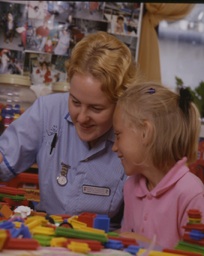
Despite improvements in survival from childhood cancer and a clear emphasis on improving effective communication, very little is known about how children with cancer perceive and learn about their illness, and how far they understand the implications. Better comprehension of the myriad of obstacles faced by children in understanding their diagnosis would be welcomed by their parents and health professionals. This project is a new initiative; through observation and discussions directly with children about their diagnosis and treatment, the project team hope to obtain a better understanding of the potential barriers in order to improve pathways to communicate with them.
A study aiming to provide a way to identify children who are most at risk from Chronic Graft versus Host disease (GVHD) after bone marrow transplants
The Bone Marrow Transplant Unit carries out around 70 transplants per year. Often children who are eligible for transplants have a high risk disease that is incurable by chemotherapy alone. The aim of BMT is to be able to deliver higher doses of chemotherapy/radiotherapy and also to use the graft as a powerful weapon against the leukaemia. Achieving a GVL (graft vs leukaemia) effect can often achieve a cure in high risk patients.
Unfortunately, this aggressive treatment also has severe risks, with some children developing severe GVHD (graft vs host disease). The graft attacks patients organs (such as their skin, gut and liver) and can persist beyond the 100 days of the transplant (chronic GVHD). Chronic GVHD is a debilitating condition significantly affecting quality of life. Often the children develop chronic sclerodermatous GVHD affecting skin and underlying tissues. When this affects limbs it reduces mobility and even the most basic skills, such as whether a child can hold a pencil or use the bathroom on their own. Increasing numbers of children with this type of chronic GVHD are now seen, as more Children are surviving the use of GVL on high risk leukaemia. Other contributory factors are the increasing use of donors who are not a perfect match for the patients and the use of peripheral blood as a stem cell source. In essence, as more Children survive cancer there are greater GVHD complications.
However, the onset of scleroderma can be insidious and schemata for the identification, staging, monitoring and documentation of disease progression are lacking. By identifying the children where early intensive intervention can help, it should be possible to prevent or reduce later disability and improve quality of life. This study aims to do that providing a rapid assessment tool, as well developing protocols for those children identified as at risk. If this is successful it will be passed onto other BMT units in the UK.
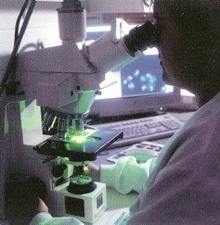
The principle of CAR (chimeric antigen receptor) gene therapy is that the patient’s own T cells (one of the killer cell subtypes of the immune system) are genetically engineered in the laboratory to express a surface protein that re-targets them against a protein (GD2) found specifically on the surface of neuroblastoma cells. The engineered cells are re-injected into the patient and the clinical and immune responses are measured. This project will fund a research assistant, to build on the existing body of preclinical data to support regulatory applications to perform a clinical trial of CAR (second generation, co-stimulating) adoptive immunotherapy, in neuroblastoma patients at Great Ormond Street Hospital. Funding for the trial has recently been awarded to ICH by the medical charity SPARKS, pending regulatory approval (£780,000). The SPARKS programme grant was awarded following publication this year in Nature Medicine of the results of a preliminary clinical trial involving a first generation anti GD2 CAR, performed at Baylor College, Houston (M Pule; Principle Investigator), and on the basis of preclinical data supporting our proposed second generation, co-stimulating CAR, generated over the last 3 years by a grant from the Neuroblastoma Society (Pule and Anderson Co-PIs;). There is intense interest in both the scientific/medical community and in the national press regarding immunotherapy for neuroblastoma because of recent unpublished results from the American Children’s Oncology Groups randomised phase3 trial showing a 20% survival advantage after 2 years in high risk patients randomized to receive anti-GD2 antibody mediated immunotherapy. However, recent reports of serious safety concerns in clinical trials with second generation (co-stimulating) CARs at the National Cancer Institute have highlighted the need for additional detailed pre-clinical experiments. This project aims to demonstrate the safety of the trial design and to allow for full regulatory clinical trial authorisation.
With a dedicated senior post doctoral fellow and a research assistant plus adequate running costs it should be possible to submit the regulatory approval application within one year. Although long term funding for the gene and cell therapy clinical trial is effectively secured, there is insufficient funding to gain regulatory approval to perform the trial safely and to the highest possible standards. This funding will enable this promising piece of research to move forward and begin clinical trials.
10% of the cost of new animal imaging equipment
This equipment will be used by all the research groups in the Molecular Haematology and Cancer Biology Unit. The Wellcome Trust have agreed to fund the equipment (total cost £138,000) subject to 10% of the funding being sourced independently. Using the OHCF funds in this way helps to unlock additional funding for the department.
The provision of laptops for the Parents Room on the Oncology wards
When a child is very sick, parents can easily become isolated from their home and family, just when they most need support. For a cost of just £800, the fund can provide Laptop computers for the Parents Room on each of the Oncology Wards, which should enable parents to keep in touch especially when a long way from home.
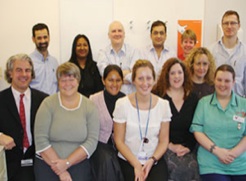
The Blood and Marrow Transplant (BMT) unit at Great Ormond Street Hospital is the largest paediatric unit in the UK, performing around 70 transplants per annum for children with high risk leukaemias and other genetic diseases. Matching the patient and donor is crucial to the success of BMT, but only 1 in 5 children has a tissue-type matched donor in their family.
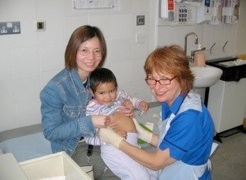
Funds from the OHCF are enabling scientists to retrospectively analyse over 100 donor/recipient pairs who proceeded to BMT at GOSH between 2001-2006, having been identified as closely matched by low resolution tissue-typing techniques. If the findings show an improved outcome for donors who were also matched at high resolution typing then this will have a profound impact on how donors are selected in the future, and could lead to further improvement in the outcome of BMT procedures.
Malignant Brain Tumours Research - Francesca Menghi
Miss Francesca Menghi is working on a PhD project funded by the Olivia Hodson Cancer Fund Committee in Dr. Jonathan Ham’s group in the UCL Institute of Child Health (ICH). Miss Menghi is studying patterns of gene expression in medulloblastomas. This is the most common malignant brain tumour in children and it develops in the cerebellum, a brain region that coordinates movement. Most cases are treated by surgery followed by radiation and/or chemotherapy. However, recurrence is common and about 60% of patients survive for 5 years after diagnosis. Understanding genetic changes that lead to their uncontrolled growth and increased resistance to programmed cell death, will lead to the development of better therapies for this serious brain tumour.
In the next stage of her PhD project, Francesca is going to study the biological function of some of the genes that are over-expressed in medulloblastomas in experiments with cultured neural progenitor cells and eventually medulloblastoma cell lines. In particular, she would like to identify genes that are important for the growth and survival of the brain tumour cells.
Click on the picture below for a pdf summary
‘What it’s like when you find eating difficult’: Food Study
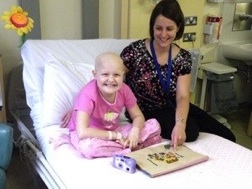
What are parent’s perception and management of eating patterns of their child during chemotherapy?
What are children’s perceptions and response to their altered eating patterns during chemotherapy?
Information gained from the food study will be used to enhance and develop the advice and support given to children and families, in relation to food intake whilst receiving chemotherapy. We would suggest that children who are just about to embark on a similar experience would appreciate the use of children’s stories. We might also anticipate that parents will reveal successful strategies that professionals may not be familiar with. The food study may also identify areas for future research that is focused on family need.
Funding for GOSH to participate in European trial of monoclonal chimeric anti-GD2 antibody against Neuroblastoma
Funding so that patients from GOSH can participate, as a single centre in the UK, in a multi-centre European trial of the monoclonal chimeric anti-GD2 antibody against neuroblastoma. The aim of the project is to reduce the side effect of pain of the anti-GD2 antibody. The project is needed because the chimeric monoclonal antibody anti-GD2, against neuroblastoma, has recently been shown by the Children’s Oncology Group (COG) in the States (data being presented at the American Society of Clinical Oncology ASCO in May 2009) to be effective in high-risk neuroblastoma (the majority of children diagnosed with this disease) in combination with the immunostimulant Interleukin 2 (IL2).
Pilot study of Pharmacokinetics of novel STAT3 inhibitors in models of childhood cancer
This is a proposal to pump prime a series of animal experiment to assess new drugs (targeting STAT3, an important regulatory molecule driving cancer) that have been generated as part of a collaboration between the University of London School of Pharmacy (chief investigators for drug discovery) and John Anderson, ICH (principle investigator for biological testing of the new agents). The current funding stream does not cover in vivo testing of new agents. Through the collaboration, several lead compounds have emerged with promising activity in vitro. However, the nature of STAT3 as a pivotal regulator of both tumour cell growth and the host-tumour microenvironment, requires detailed in vivo analysis. This pump prime grant application is designed, quickly to answer the question of whether the current lead compounds already have activity in vivo. If positive this should provide sufficient data to fund a detailed body of work to determine activity of the agents in vivo. Moreover the in vivo data will provide vital information for directing the drug development.
Funding for physiotherapist Lucy Waller to attend a specialist rehabilitation course
OHCF sponsored Lucy Waller to attend an 8 week rehabilitation course at the Bobath Institute which helped her gain extra expertise and skills in the assessment and treatment of children with Haematology/Oncology diagnoses who unfortunately suffer often devastating and complex neurological problems in order to provide the children and families with the support and treatment required to achieve the best possible functional outcome. After attending the course, one example of a patient she helped to recover is Jake Peach (the star of a Teens First for Health video diary and Pride of Britain Award winner) - see video here: http://www.youtube.com/watch?v=AmvEYZi1Db4&
PHD Study: The Application of genes expression classification to diagnose paediatric leukaemias - Ruth Lyons
This project tested the performance of a gene expression based method for diagnosing leukaemia. Rapid diagnosis of AML or ALL is essential for immediate implementation of the correct treatment and the best patient outcome. This project was very successful and will hopefully become part of clinical practice resulting in better and faster diagnosis in difficult cases.
Functional Imaging in Childhood Cancer - Dr Joanna Begent
FDG-PET scanning allows glucose uptake to be monitored in cells in solid tumours. In malignant tumours there is increased glucose uptake by the cells and by comparing the scans before surgery with cross sectional imaging and histology of the tumour after surgery,greater understanding of the relationship between glucose uptake and malignancy can be gained. This has allowed doctors to monitor responses to therapy and allow better monitoring. Joanna went on to help form two new national committees, one in association with CCLG to look at research projects and one as part of the UK PET-CT Advisory Board which addresses practical issues relating to these scans in children.
Palliative care - Dr. Ann Goldman
Dr. Goldman is a consultant at GOSH responsible for Palliative Care. She visited Hong Kong, funded by OHCF, at the request of Dr. S.Y. Ha from Queen Mary’s Hospital. Children's Palliative care is in the early stages of development in Hong Kong. Dr. Goldman spent a week visiting hospitals (adult and children’s), hospices and other organisations, conducting workshops and giving lectures to a wide range of medical staff. Dr. Ha and Dr. Goldman have produced practical plans for enhancing palliative care in Hong Kong, which will include at least one member of the nursing staff spending time with the team at GOSH.
Providing psychological help to children with cancer
In 1999 OHCF helped to fund Dr Myra Bluebond-Langer's study into decision making for terminally-ill children and a copy of an article written about this study is included below. The Journal of Clinical Oncology is the "Flagship" journal in oncology, reaching all oncology clinicians globally. It is an important study and we are proud to have been the first to have given funding for it. Myra Bluebond Langer is Professor of Anthropology at Rutgers University, USA.
Click here to see the journal article
Providing psychological help to children with cancer
The Olivia Hodson fund has been funding a part time clinical psychologist working across the haematology and oncology wards at Great Ormond Street Hospital for the past 18 months. Dr Anna Hutchinson has been in this role, providing additional psychological support to children, their siblings, parents and staff. Working alongside psychology and social work colleagues, Anna works to help families discuss and adjust, as much as is possible, to a diagnosis of cancer in their child. This includes one to one work with the young people.

For parents, there are often concerns around their own ability to cope. Some families spend many months living on the wards, witnessing the impact of illness and treatments on their own and other children. They often request help in explaining the situation to their children. Anna sometimes offers counselling to couples. Receiving a diagnosis and then witnessing the impact of the treatment on a child is extremely traumatic experience. On a practical level, there are many impacts on a family and some suffer from financial concerns due to having to change their work practices. As a result it can often lead to conflict within couples, which can of course make a difficult time even harder for the families and children.
As well as providing extra support to the wards, Anna’s post has enabled direct access to psychology for the palliative care team for the first time. To date this support has mainly comprised of providing home visits. This has been a particularly beneficial improvement in the service that the families receive as many are unable to visit the hospital for any appointments beyond those that are absolutely essential. Home visits allow for more time to be spent meeting siblings and talking about the needs that the whole family will have when a child is receiving palliative care.
Finally, Anna completed an audit of staff stress and coping in July 2007, with 106 staff being questioned. As a result a new service is currently being piloted to support the staff who are supporting the children and families. This new service comprises of confidential one-to-one support available if/when needed & monthly staff support for young nurses.
As well as improving access to psychological support for many patients and staff, this role has reinforced the need to think about the impact that cancer has upon the whole child and family. As a result, it is hoped that further psychological resources will be provided to these patients in the future.
Services for long term survivors of Childhood Cancer - Philip Mardlin
Philip Mardlin visited the United States in order to examine services for long term survivors of childhood cancer. The fund paid for this trip so that GOSH could improve their program for survivors of childhood cancer in the UK by learning from the US models.
Development of a pain management algorithm
This project involved four senior nurses (Faith Gibson (South Bank University and GOSH), Neeltje Langeveld (University of Amsterdam), Louise Soanes (South Bank University), Cynthia Wenden (GOSH)) in developing a pain management algorithm which allows early intervention in the management of pain in children with cancer.
Research Into Cell Death in Tumour Cells - Dr Elvira Crescenzi
While working at the University of Naples, OHCF paid for Dr Crescenzi to spend one year at ICH investigating cell death with particular interest in the role of the protein BC1-2 in solid tumours. A copy of the paper submitted to the journal of Biochemistry can be viewed by clicking here.

© 2011 Olivia Hodson Cancer Fund
